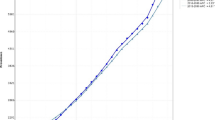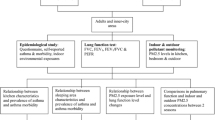Abstract
Objective
It is crucial to study the possible health effects of household air pollution (HAP).
Methods
Eligible rural (n = 58) and county women (n = 10) were enrolled in this study as research and control groups to explore the relationship between the HAP and potential health effects on rural women in northwest China. Firstly, a questionnaire on general characteristics of subjects was conducted. Next, in the non-heating (September 2019) and heating seasons (March 2020), the average concentrations of respirable particulate matter 10 (PM10) and fine particulate matter (PM2.5) in living rooms of rural subjects were monitored and health indicators of all subjects were measured. The levels of Malondialdehyde (MDA), 1-Hydroxypyrene (1-OHP),and producing 8-hydroxy-2-deoxyguanosine (8-OHdG) and the activity of Superoxide dismutase (SOD) of all subjects in urine samples in two seasons were detected.
Results
The questionnaire results revealed that economic level, house structure, local lifestyle, and seasonal fuel energy type were influence factors relatively high exposure to HAP during the heating season, and all subjects had a certain of self-management of blood pressure. However, there were deficiencies in rural subjects in terms of regular checkups and medication taking. The average PM10 and PM2.5 concentrations during the heating season were significantly higher than those in the non-heating season. Meanwhile, systolic blood pressure (SBP) and Diastolic blood pressure (DBP) of the rural subjects showed significant seasonal changes and SBP was significantly higher than those in the county subjects during the heating season. The 1-OHP, MDA, SOD, and 8-OHdG levels of rural subjects increased significantly in the heating season compared with the non-heating season and county subjects (P < 0.01).
Conclusion
Rural women in northwest China were exposed to higher HAP due to lifestyle in heating season, which could cause changes in blood pressure as well as oxidative stress levels. Therefore, it is important to further explore the mechanism on oxidative stress involved in high blood pressure induced by HAP.




Similar content being viewed by others
References
Chen Y, Fei J, Sun Z, Shen G, Du W, Zang L, Yang L, Wang Y, Wu R, Chen A (2020) Household air pollution from cooking and heating and its impacts on blood pressure in residents living in rural cave dwellings in Loess Plateau of China. Environ Sci Pollut Res 27:36677–36687
Conibear L, Butt EW, Knote C, Lam NL, Arnold SR, Tibrewal K, Venkataraman C, Spracklen DV, Bond TC (2020) A complete transition to clean household energy can save one–quarter of the healthy life lost to particulate matter pollution exposure in India. Environ Res Lett 15:094096
Delapena S, Piedrahita R, Pillarisetti A, Garland C, Rossanese ME, Johnson M, Pennise D (2018) Using personal exposure measurements of particulate matter to estimate health impacts associated with cooking in peri-urban Accra, Ghana. Energy Sustain Dev 45:190–197
Zhao J, Li M, Wang Z, Chen J, Zhao J, Xu Y, Wei X, Wang J, Xie J (2019) Role of PM2.5 in the development and progression of COPD and its mechanisms. Respir Res 20:1–13
Li T, Hu R, Chen Z, Li Q, Huang S, Zhu Z, Zhou L-F (2018) Fine particulate matter (PM2.5): The culprit for chronic lung diseases in China. Chronic Dis Transl Med 4:176–186
Wang L, Luo D, Liu X, Zhu J, Wang F, Li B, Li L (2021) Effects of PM2.5 exposure on reproductive system and its mechanisms. Chemosphere 264:128436
Ali MU, Yu Y, Yousaf B, Munir MAM, Ullah S, Zheng C, Kuang X, Wong MH (2021) Health impacts of indoor air pollution from household solid fuel on children and women. J Hazard Mater 416:126127
Ezzati M, Kammen DM (2002) The health impacts of exposure to indoor air pollution from solid fuels in developing countries: knowledge, gaps, and data needs. Environ Health Perspect 110:1057–1068
Wang B, Wang Z, Zhao X, Huang N, Duan X, Jiang Y, Wang L (2014) Study of indoor and outdoor activity time for adults in China. Environment and Health Journal 31:945–948
Wu F, Liu X, Wang W, Man YB, Chan CY, Liu W, Tao S, Wong MH (2015) Characterization of particulate-bound PAHs in rural households using different types of domestic energy in Henan Province, China. Sci Total Environ 536:840–846
Orakij W, Chetiyanukornkul T, Kasahara C, Boongla Y, Chuesaard T, Furuuchi M, Hata M, Tang N, Hayakawa K, Toriba A (2017) Polycyclic aromatic hydrocarbons and their nitro derivatives from indoor biomass-fueled cooking in two rural areas of Thailand: a case study. Air Qual Atmos Health 10:747–761
Du W, Chen Y, Shen G, Wang W, Zhuo S, Huang Y, Pan X, Tao S (2018) Winter air pollution by and inhalation exposure to nitrated and oxygenated PAHs in rural Shanxi, north China. Atmos Environ 187:210–217
Yao Y, Wang D, Ma H, Li C, Chang X, Low P, Hammond SK, Turyk ME, Wang J, Liu S (2019) The impact on T-regulatory cell related immune responses in rural women exposed to polycyclic aromatic hydrocarbons (PAHs) in household air pollution in Gansu, China: a pilot investigation. Environ Res 173:306–317. https://doi.org/10.1016/j.envres.2019.03.053
Huang Y, Wang H, Guo H, Liu Y, Zeng Y, Hu F, Zhang W, Li C, Wang J (2022) A preliminary study on household air pollution exposure and health-related factors among rural housewives in Gansu province, northwest China. Archiv Environ Occup Health 77:662–673
Ma H, Wang H, Zhang H, Guo H, Zhang W, Hu F, Yao Y, Wang D, Li C, Wang J (2020) Effects of phenanthrene on oxidative stress and inflammation in lung and liver of female rats. Environ Toxicol 35:37–46. https://doi.org/10.1002/tox.22840
Ma H, Guo H, Zhang W, Hu F, Huang Y, Zeng Y, Liu Y, Li C, Wang J (2020) The effects of phenanthrene exposure on Treg and Th17 cells related cytokines in female rats. Toxicology Research 9:283–289
Guo H, Zhang Z, Wang H, Ma H, Hu F, Zhang W, Liu Y, Huang Y, Zeng Y, Li C, Wang J (2020) Oxidative stress and inflammatory effects in human lung epithelial A549 cells induced by phenanthrene, fluorene, and their binary mixture. Environ Toxicol. https://doi.org/10.1002/tox.23015
Swann S, Beach K, Ehmke S, Rice NA (2020) Household air pollution indicators and epigenetic changes in the renin angiotensin system genes ACE and AGTR1. FASEB J 34:1–1
Arku RE, Birch A, Shupler M, Yusuf S, Hystad P, Brauer M (2018) Characterizing exposure to household air pollution within the prospective urban rural epidemiology (PURE) study. Environ Int 114:307–317. https://doi.org/10.1016/j.envint.2018.02.033
Wu S, Xu Y, Zheng R, Lu J, Li M, Chen L, Huo Y, Xu M, Wang T, Zhao Z, Wang S, Lin H, Dai M, Zhang D, Niu J, Qin G, Yan L, Wan Q, Chen L, Shi L, Hu R, Tang X, Su Q, Yu X, Qin Y, Chen G, Gao Z, Wang G, Shen F, Luo Z, Chen Y, Zhang Y, Liu C, Wang Y, Wu S, Yang T, Li Q, Mu Y, Zhao J, Bi Y, Wang W, Ning G (2022) Hypertension Defined by 2017 ACC/AHA Guideline, ideal cardiovascular health metrics, and risk of cardiovascular disease: a nationwide prospective cohort study. Lancet Regional Health Western Pacific 20:100350. https://doi.org/10.1016/j.lanwpc.2021.100350
Mohapatra I, Das SC, Samantaray S (2018) Health impact on women using solid cooking fuels in rural area of Cuttack district, Odisha. J Family Med Primary Care 7:11
Wang B, Zhu Y, Pang Y, Xie J, Hao Y, Yan H, Li Z, Ye R (2018) Indoor air pollution affects hypertension risk in rural women in Northern China by interfering with the uptake of metal elements: a preliminary cross-sectional study. Environ Pollut 240:267–272
Harrison DG (2013) The mosaic theory revisited: common molecular mechanisms coordinating diverse organ and cellular events in hypertension. J Am Soc Hypertens 7:68–74
Deng L, Liu W, Xu Q, Guo R, Zhang D, Ni J, Li L, Cai X, Fan G, Zhao Y (2022) Tianma Gouteng Decoction regulates oxidative stress and inflammation in AngII-induced hypertensive mice via transcription factor EB to exert anti-hypertension effect. Biomed Pharmacother 145:112383. https://doi.org/10.1016/j.biopha.2021.112383
Gonzalez-Martin J, Kraakman NJR, Perez C, Lebrero R, Munoz R (2021) A state–of–the-art review on indoor air pollution and strategies for indoor air pollution control. Chemosphere 262:128376
Aung ZY, Htut YN, Aye KK, Tun KM, Tun SNL, Htut T (2020) Indoor particulate matter (PM2.5) concentration and lung function impairment among housewives of selected quarters in Mingaladon cantonment. IOP Conf Series Earth Environ Sci 496(1):012002
Tong R, Cao L, Yang X, Zhang B (2021) Health damage to housewives by contaminants emitted from coal combustion in the Chinese countryside: focusing on day-to-day cooking. Int Arch Occup Environ Health 94:1917–1929
Morawska L, Afshari A, Bae G, Buonanno G, Chao CYH, Hänninen O, Hofmann W, Isaxon C, Jayaratne ER, Pasanen P (2013) Indoor aerosols: from personal exposure to risk assessment. Indoor Air 23:462–487
Wan M-P, Wu C-L, To G-NS, Chan T-C, Chao CY (2011) Ultrafine particles, and PM2.5 generated from cooking in homes. Atmos Environ 45:6141–6148
Jahn HJ, Kraemer A, Chen X-C, Chan C-Y, Engling G, Ward TJ (2013) Ambient and personal PM2.5 exposure assessment in the Chinese megacity of Guangzhou. Atmos Environ 74:402–411
Du W, Wang J, Zhang S, Fu N, Yang F, Wang G, Wang Z, Mao K, Shen G, Qi M (2021) Impacts of Chinese spring festival on household PM2. 5 pollution and blood pressure of rural residents. Indoor Air 31:1072–1083
Vogel CF, Van Winkle LS, Esser C, Haarmann-Stemmann T (2020) The aryl hydrocarbon receptor as a target of environmental stressors–Implications for pollution mediated stress and inflammatory responses. Redox Biol 34:101530
Huang Y-d, Hou J, Xu T, Yin W-j, Cheng J, Zheng H-y, Yuan J (2020) Non-linear relationships between seasonal exposure to polycyclic aromatic hydrocarbons and urinary 8-hydroxy-2′-deoxyguanosine levels among Chinese young students. Chemosphere 251:126352
Dutta A, Ray MR, Banerjee A (2012) Systemic inflammatory changes and increased oxidative stress in rural Indian women cooking with biomass fuels. Toxicol Appl Pharmacol 261:255–262
Gaudreau É, Bérubé R, Bienvenu J-F, Fleury N (2016) Stability issues in the determination of 19 urinary (free and conjugated) monohydroxy polycyclic aromatic hydrocarbons. Anal Bioanal Chem 408:4021–4033
Kang R-H, Wang Y-S, Yang H-M, Li G-R, Tan X, Xue J-H, Zhang J-Q, Yuan Y-K, Shi L-F, Xiao X-L (2010) Rapid simultaneous analysis of 1-hydroxypyrene, 2-hydroxyfluorene, 9-hydroxyphenanthrene, 1-and 2-naphthol in urine by first derivative synchronous fluorescence spectrometry using Tween-20 as a sensitizer. Anal Chim Acta 658:180–186
Acknowledgements
This study was supported by the National Natural Science Foundation of China (81828011). The authors thank the residents who volunteered to participate in this study.
Author information
Authors and Affiliations
Corresponding author
Ethics declarations
Conflict of interest
Yamin Huang, Yushan Huang, Huiling Wang, Jinping Fan, Xiangli Li, Chengyun Li, Haojun Zhang, and Junling Wang declare that they have no competing financial interest.
Ethical approval
This field study was approved by the Human Subject Protection Committee of Lanzhou University (Project ID: IRB2018003).
Rights and permissions
Springer Nature or its licensor (e.g. a society or other partner) holds exclusive rights to this article under a publishing agreement with the author(s) or other rightsholder(s); author self-archiving of the accepted manuscript version of this article is solely governed by the terms of such publishing agreement and applicable law.
About this article
Cite this article
Huang, Y., Huang, Y., Wang, H. et al. Exposure levels and possible health effects of HAP on rural housewives in northwest China. Toxicol. Environ. Health Sci. 15, 73–84 (2023). https://doi.org/10.1007/s13530-022-00162-5
Accepted:
Published:
Issue Date:
DOI: https://doi.org/10.1007/s13530-022-00162-5




